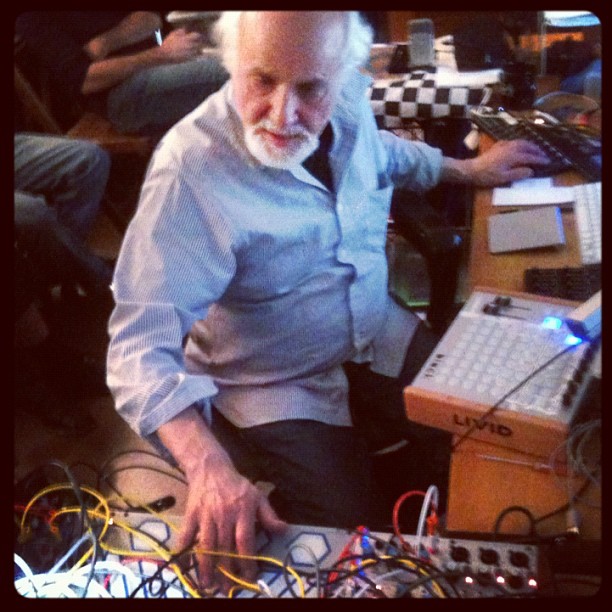Morton Subotnick is a composer, educator and innovator.
His 1967 album Silver Apples of the Moon was the first electronic music written for commercial release. It utilised something now described as a synthesiser, the Buchla 100, an instrument Subotnick commissioned (with Ramon Sender for the San Francisco Tape Music Centre) and labelled a “music easel’. Buchla joined Moog with the first synthesisers in commercial production in the 1960s and, after being unavailable for nearly 40 years, the Buchla Easel returned to the marketplace in 2013.
Ahead of Subotnick’ performance of Silver Apples as part of the Unsound program at the Adelaide Festival, the man who can arguably be seen as the father of recorded electronic music spoke with Cyclic Defrost’s Jason Richardson.
Jason: What was your introduction to synthesisers?
Morton: There wasn’ a synthesiser. There was the RCA Mark II at Columbia University but nothing like what we now know as a synthesiser.
What I thought at the time, the transistor has just become a commercial reality and it seemed to me there should be a new music. A music for the new technology. The word synthesiser for me was for synthesised music. I called it an easel, which was the name I gave to Buchla. I meant it as a metaphor for using colour on a canvas.
Jason: What’s your live set-up these days?
Morton: I’m using the new Buchla and a computer running Ableton Live.
For years I tried playing live but required mountains of gear. I tried digital but it didn’t suit me. The new Buchla does things I couldn’t do before and it interfaces with Ableton Live.
Jason: What advice do you give musicians in your guest lectures at New York University?
Morton: I try not to give advice. It’s a wonderful group of students there, they seem better every year, or maybe I’m getting worse? (Laughs)
I try to expand their horizons. Synthesisers expanded my thinking. People ask me how you choose from all the equipment that’s available today, but I try to get them to think how to express themselves. One exercise is to use one oscillator on one pitch to develop a piece. I try to give them experience.
Now there are infinite possibilities. I hear it a lot that there are many options and it can be a challenge to think of working within constraints.
As soon as you use changing pitches they’re dominate everything else. We’re still using scales in most music, so our pitch knowledge hasn’t expanded. Our pitch knowledge is the tail wagging the dog. We need to be able to realise other musical gestures. We’re stuck using scales and these shape our understanding of pitch when there are pitches between notes. And there are other forms of musical expression such as gestures of changing amplitudes and timbres.
Jason: What do you like about Ableton Live?
Morton: What I like about Ableton Live is the lack of a single musical metaphor. Many programs tell you what they think you want to make.Ableton offers a panel (in session view) and you can recognise it’s like a mixer with all the inputs and outputs and routing options and other possibilities. It’s not modelling a piano and it’s not modelling a synthesiser. It’s a vessel, unlike most things that are already full. It’s an easel, a platform on which to create work.
I don’t know if I used the first envelope follower but I asked Buchla to make something that I could use to control with my voice. I used my voice as a gestural control and, through control voltage, I was able to insert myself in a real way into the technology.
I think we’re moving in a direction where control, through gesture isn’t being developed. It seems we’re getting very close but it’s not there. I had better expressivity using an envelope follower and my voice than some of the controller interfaces now being offered. For example, waving your hands through the air is very limited. If you’re expressing how you feel, waving is quite basic. It’s nice but very limited. We wouldn’t have to improve on the voice, but if the interface was more sensitive to pitch and timbre it would be more expressive. It isn’t that waving isn’t a good thing, but it isn’t operating at the multi-dimensional level that our feelings are.
Jason: Are there any developments that point to interesting future directions?
Morton: Marshall McLuhan has a wonderful quote “We march backwards into the future looking through a rear[view mirror.” I’ve always thought I was moving away from linearity through my career but I can see aspects that have been consistent. Each of us look back differently and some things stand out because we look at them in isolation.
There’ a quote from Plato where he argues against introducing new things in music, but we don’t know what these new things were, where because there’ no record of that. We only know that people were doing new things. It’s there because he said you shouldn’t do it! We don’ know what was happening back there.
I’m trying to offer perspective, not only on the present state of being musicians but the present state of being human.
One of the observations, as I’m writing my memoirs for MIT Press, is the idea I’ve latched onto that, from Aristotle onwards we’ve been viewing history as a river. I think what’s happening is there’s no direction. Things explode in all directions. I don’t think people pick up on the past, I think as they’re developing technology they’ve brought me forward.
Morton Subotnick performs Silver Apples of the Moon
alongside Nurse With Wound, Lee Gamble & Cut Hands
Fri 7 Mar as part of Unsound at the Adelaide Festival




